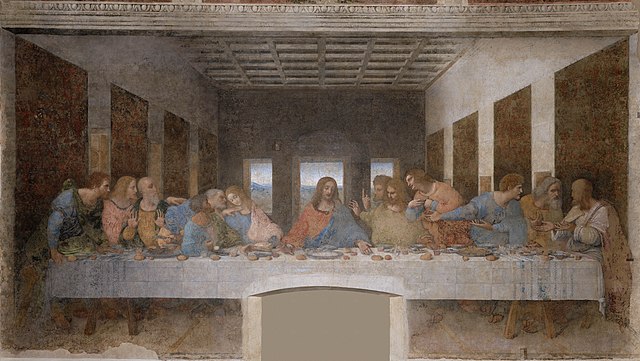
Name: The Last Supper
Artist: Leonardo da Vinci
Date Painted: c. 1495 – 1498
Period: Renaissance
Dimensions: 460 cm (h) x 880 cm (w)
Medium / Material: Tempera on Gesso, Pitch and Mastic
Current Location: Santa Maria delle Grazie, Milan, Italy
Introduction
Leonardo da Vinci’s “The Last Supper” is one of the most iconic and widely recognized paintings in the world. Completed in 1498, it covers the back wall of the dining hall at Santa Maria delle Grazie in Milan, Italy. This mural captures the dramatic moment during the Last Supper, when Jesus announces that one of his twelve disciples will betray him. Leonardo’s work is celebrated for its artistic mastery, emotional depth, and complex symbolism, showcasing his genius in conveying human emotion and spatial organization.
Composition and Perspective
“The Last Supper” measures 29 feet by 15 feet, making it an imposing work. Leonardo employed a masterful use of perspective to draw the viewer’s attention directly to the central point of the composition: Jesus Christ. The perspective lines emanate from Christ’s head, emphasizing his spiritual and narrative significance. The architectural elements and the orthogonal lines of the coffered ceiling and the tapestries on the walls converge towards this focal point, creating a realistic sense of depth and space.
Emotional and Psychological Realism
Leonardo broke new ground with “The Last Supper” by capturing a specific moment of high drama and imbuing each of the apostles with a unique, identifiable emotional response. From shock to disbelief, to grief, Leonardo portrayed a wide range of human emotions with unprecedented realism. This psychological depth is a testament to his study of human anatomy, gesture, and facial expression.
Grouping and Individuality
The apostles are grouped into four sets of three, each reacting differently to Jesus’ announcement. This grouping creates rhythm and balance within the composition, while also allowing each figure to have a distinct reaction. Leonardo’s careful arrangement of these groups and his attention to the individual reactions of the apostles contribute to the narrative complexity of the painting.
Symbolism
The painting is rich in symbolic elements. For example, the placement of the apostles and their gestures can be interpreted in various ways, reflecting their roles and relationships with Jesus. Judas Iscariot is depicted clutching a small bag, signifying his role as the treasurer as well as the silver pieces he was given to betray Jesus. His placement in shadow contrasts with the light surrounding Jesus, symbolizing his alienation from the divine light.
Technique and Conservation
Leonardo experimented with an oil-based medium instead of the traditional fresco technique, which allowed him greater flexibility in making changes. However, this choice also contributed to the painting’s deterioration over time. “The Last Supper” has undergone numerous restorations to address issues of flaking, fading, and damage from environmental factors and human intervention. These restorations have been controversial but necessary to preserve this masterpiece for future generations.
Legacy
“The Last Supper” has profoundly influenced the development of Western art, setting new standards for composition, emotional depth, and narrative art. Its iconic status has made it a subject of admiration, study, and even reinterpretation across various media. Leonardo da Vinci’s innovative approach to depicting this biblical scene has cemented “The Last Supper” as a seminal work in the history of art, showcasing his unparalleled ability to combine scientific inquiry, artistic mastery, and deep humanism.